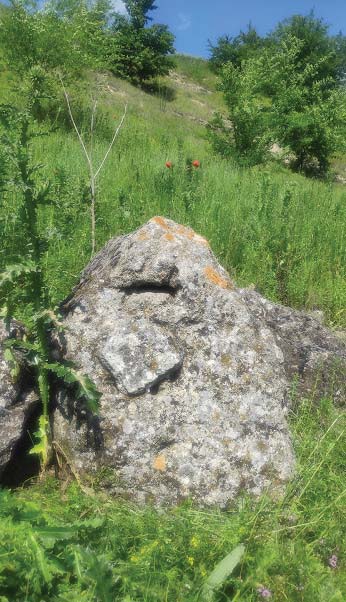THE NEW ANTHROPOMORPHIC STONE STELE WITH A SINGLE SARMATIAN TAMGA FROM THE GORGE OF THE RIVER OF SOLONETS
DOI:
https://doi.org/10.24852/2587-6112.2021.5.335.342Keywords:
archaeology, Republic of Moldova, Roşieticii Vechi, Reut river, Solonets river, steppe, the Sarmatians, cult object, anthropomorphic statue, stone stele, tamgaAbstract
The new anthropomorphic stone stele with a single Sarmatian tamga, originating from the Solonets River gorge and located near Rosieticii Vechi and Rogojeni in Northern Moldavia, does not belong to the typical Sarmatian stone steles. A Sarmatian tamga is carved on the face of the monument. This symbol has a number of analogies in terms of the carving pattern which are found in the region of Northern Moldavia and Southern Ukraine. The front side of the anthropomorphic statue is oriented to the South, and to the opposite gentle slope of gorge, on which there presumably was an ancient road leading to a ford and a watering hole. The stele with a single Sarmatian tamga on the mask is also the center of a cluster of three stones, which are located on different sides of the stele and bear traces of machining in the form of notches, hollows, niches, and groove-shaped depressions, which can also imply the possible cult orientation of the complex. The anthropomorphic statue served as a sign indicating the ford on the river and the watering hole for people and horses. At the same time, it could have been a cult object of sacred worship of a deity associated with water. Also, the stele could have been used as a stone marking the borders of the Sarmatian domain.
References
Agul’nikov, S., Bubulich, V. 2010. In Tyragetia. vol. IV [XIX], nr. 1, 205–208 (in Russian).
Akishev, A. K. 1984. Iskusstvo i mifologiia sakov (Art and Mythology of the Saka). Alma-Ata: “Nauka” Publ. (in Russian).
Solomonik, E. I. 1959. Sarmatskie znaki Severnogo Prichernomor'ia (Sarmatian Signs from the Northern Black Sea Region). Кiev: Academy of Sciences of the Ukrainian SSR Publ. (in Russian).
Gukin, V. D. 1991. In Byrnia, P. P. (ed.). Arkheologicheskie issledovaniia v Starom Orkhee (Archaeological Studies in Old Orhei). Kishinev: “Shtiintsa” Publ., 68–71 (in Russian).
Drachuk, V. S. 1972. In Kratkie soobshcheniia Instituta arkheologii (Brief Communications of the Institute of Archaeology). 130. Moscow: “Nauka” Publ., 105–111 (in Russian).
Drachuk, V. S. 1975. Sistemy znakov Severnogo Prichernomor'ia (Tamgoobraznye znaki severopontiiskoi periferii antichnogo mira pervykh vekov nashei ery). (Sign Systems of the Northern Black Sea Region (Tamga Signs of the Northern Pontic Periphery of the Ancient World of in First Centuries of the Common Era). Kiev: “Naukova dumka” Publ. (in Russian).
Kurchatov, S. 2014. In Revista Arheologică. 10 (1–2). 132–142 (in Russian).
Raevsky, D. S. 2018. In Nartamongae Vol. XIII, N 1, 2, 37–52.
Demchenko, N. A. (ed.). 1987. Svod pamyatnikov istorii i kultury Moldavskoi SSR. Severnaia zona (Corpus of Sites of Historical and Cultural of the Moldova ASSR. Northern zone). Kishinev: “Shtiintsa” Publ. (in Russian).
Gasanov, Z. 2002. Tsarskie skify. Etnoiazykovaia identifikatsiia «tsarskikh skifov» i drevnikh oguzov (Royal Scythians. Ethno-Lingual Identification of the “Royal Scythians” and the Ancient Oghuz). New York: Liberty Publishing House (in Russian).

Downloads
Published
How to Cite
Issue
Section
License
Copyright (c) 2021 Bondar Igor A.

This work is licensed under a Creative Commons Attribution-NonCommercial 4.0 International License.







